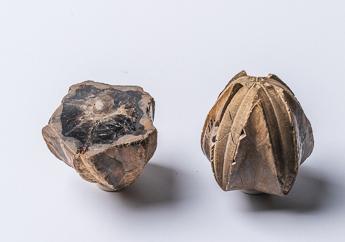Missouri Geological Survey Director: Carey Bridges, RG
Blastoids are an extinct group of stemmed echinoderm invertebrate animals that lived in the marine environment during the Paleozoic Era from early Silurian time to late Permian time, about 255 to 440 million years ago.

of blastoid species Pentremites pyriformis from
325-million-year-old upper Mississippian limestone.
Blastoids are related closely to another group of similar-looking stemmed echinoderms called crinoids. Blastoids differ from crinoids in having a more highly developed five-sided (pentamerous) symmetry and specialized anatomical features that are lacking in crinoids. Also, blastoids tended to be smaller in size and shorter stemmed. The blastoid body, like that of a crinoid, consisted of four main divisions: a nut-like, five-sided calyx that housed vital organs; branching arms that radiate from the calyx that were used for gathering food; a short column (stem or stalk) that extended down from the bottom of the calyx; and rootlets that branched out from the bottom of the column that were used to anchor the animal to the seafloor. Each body division was composed of numerous, hard, calcareous pieces (ossicles) that were held together by ligaments and connective tissue. These formed a skeletal framework that was supportive, protective and flexible enough to afford some degree of body movement.
After the animal died, the arms, stems and rootlets readily fell apart and scattered across the sea floor. Their calyxes, however, were more resistant and tended to remain intact long enough to become fossilized. Most of what is known about blastoids is based on their fossilized calyxes. Fossil specimens with their stems attached are rare. The typical calyx seldom exceeds one inch in diameter, though the calyx of one species that lived during the late Mississippian time is about 2 inches in diameter.
Next to nothing is known about the larval and early growth stages of blastoids. The fossil record indicates the calyx shape progressively changed from thin and longitudinally elongated for small, young calyxes to short and wide, almost globular, for large adult calyxes. The large calyxes look fat or bloated, and it has been stated that “old-age blastoids have a tendency to become obese.”
Being a filter feeder, blastoids were known to inhabit marine environments that had some degree of water agitation. Fossil blastoids typically are found in association with rugose corals, fenestrate bryozoans, brachiopods and crinoids. The shell-crusher sharks of the Paleozoic Era likely grazed on blastoid and crinoid calyxes.
Blastoids and other fossils are on display in our Ed Clark Museum of Missouri Geology.
Nothing in this document may be used to implement any enforcement action or levy any penalty unless promulgated by rule under chapter 536 or authorized by statute.
For more information
Geological Survey Program
Missouri Geological Survey
P.O. Box 250
Rolla, MO 65402-0250
United States
